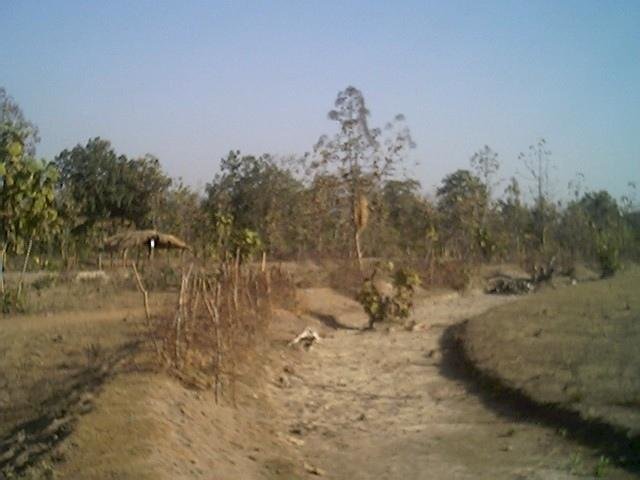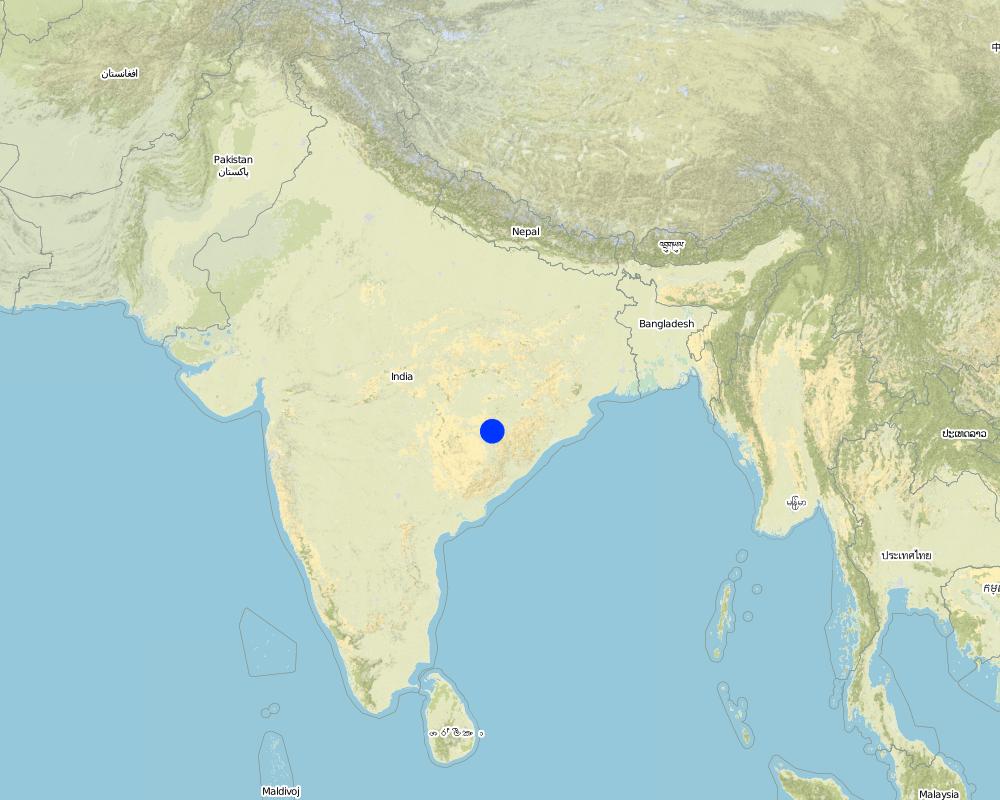Participatory Sustainable Rural Livelihood Approach [ប្រទេសឥណ្ឌា]
- ការបង្កើត៖
- បច្ចុប្បន្នភាព
- អ្នកចងក្រង៖ Niranjan Sahu
- អ្នកកែសម្រួល៖ –
- អ្នកត្រួតពិនិត្យ Fabian Ottiger
approaches_2367 - ប្រទេសឥណ្ឌា
ពិនិត្យមើលគ្រប់ផ្នែក
ពង្រីកមើលទាំងអស់ បង្រួមទាំងអស់1. ព័ត៌មានទូទៅ
1.2 ព័ត៌មានលម្អិតពីបុគ្គលសំខាន់ៗ និងស្ថាប័នដែលចូលរួមក្នុងការវាយតម្លៃ និងចងក្រងឯកសារនៃវិធីសាស្ត្រផ្សព្វផ្សាយ
អ្នកជំនាញឯកទេស SLM:
ឈ្មោះអង្គភាពមួយ (ច្រើន) ដែលបានចងក្រងឯកសារ/ វាយតម្លៃលើវិធីសាស្ត្រផ្សព្វផ្សាយ (បើទាក់ទង)
Orissa Watershed Developemnt Mission - ប្រទេសឥណ្ឌា1.3 លក្ខខណ្ឌទាក់ទងទៅនឹងការប្រើប្រាស់ទិន្នន័យដែលបានចងក្រងតាមរយៈវ៉ូខេត
អ្នកចងក្រង និង(បុគ្គលសំខាន់ៗ)យល់ព្រមទទួលយកនូវលក្ខខណ្ឌនានាទាក់ទងទៅនឹងការប្រើប្រាស់ទិន្នន័យដែលបានចងក្រងតាមរយៈ វ៉ូខេត:
បាទ/ចា៎
1.4 ការយោងមួយ (ច្រើន) ទៅលើ (កម្រង) បញ្ជីសំណួរនៃបច្ចេកទេស SLM

Contour Trench cum Bund [ប្រទេសឥណ្ឌា]
Contour trench cum bund is a bund laid out on contour along with trench either staggered or continuous to check the velocity of run off, conserve in situ moisture, increse ground water recharge and there by establish a sustainable land use system.
- អ្នកចងក្រង៖ Niranjan Sahu
2. ការពណ៌នាអំពីវិធីសាស្ត្រផ្សព្វផ្សាយ SLM
2.1 ពណ៌នាសង្ខេបខ្លីពីវិធីសាស្ត្រផ្សព្វផ្សាយ
Participatory Sustainable Rural Livelihood Approach adopts participatory tools for livelihood situational analysis of the five capitals(Physical, Financila,Social, Human and Natural) and prepare livelihood focussed micro plan with the commuity for sustai
2.2 ពណ៌នាលម្អិតពិវិធីសាស្ត្រផ្សព្វផ្សាយ
ពណ៌នាលម្អិតពិវិធីសាស្ត្រផ្សព្វផ្សាយ:
Aims / objectives: Participatory Sustainable Rural Livelihood Approach uses the DFID's Sustainable Rural Livelihood Framework. The approach adopts participatory processes during planning, implementation, monitoring and evaluation.The out put of the planning process is a livelihood focussed micro plan. The process of micro plan preparation with the community consists of rapport building, livelihood situational analysis, problem identification and prioritisation, negotiation and development of action plan. The livelihood situational analysis focuses on identifying the strength of the community by diagonising the five capitals(Physical, Natural, Financial, Social, Human) and suggest options for livelihood improvement. Objective: 1.Livelihood improvement of the poor and vulnerable.2. Creating an enabling environment 3. Capacity building of the primary and secondary stake holders.Out puts:1.Enhanced and sustainable livelihood options for resource poor and disadvantaged identified and supported in project areas. 2.Resource poor and disadvantaged organised in project areas to effectively identify, plan and implement livelihood activities and participate in wider for a and processes.3.GO,PRI, NGO,PIA work effectively with communities on (pro poor) livelihoods and initiatives in four project districts. 4.Strategic constraints to livelihood of resource poor and disadvantaged are identified and reviewed and improvements proposed to Government.5.Appropriate approaches and interventions developed through the project are replicated in the four project districts and disseminated within Orissa and national level for a.
Methods: Participatory, Collaborative and Convergence. Stages of implementation: Rapport building,Community mobilistion, Preparation of micro plan, Formation of village level institutions, implementation, monitoring and evaluation.
Role of stakeholders: Community members are actors and all others are facilitators.
2.5 ប្រទេស/តំបន់/ទីតាំងកន្លែង ដែលវិធីសាស្ត្រផ្សព្វផ្សាយត្រូវបានអនុវត្តន៍
ប្រទេស:
ប្រទេសឥណ្ឌា
តំបន់/រដ្ឋ/ខេត្ត:
Orissa
Map
×2.6 កាលបរិច្ឆេទនៃការចាប់ផ្តើម និងបញ្ចប់នៃវិធីសាស្រ្តផ្សព្វផ្សាយនេះ
សូមបញ្ជាក់ឆ្នាំដែលបានបង្កើតឡើង:
2002
ឆ្នាំបញ្ចប់ (ប្រសិនបើវិធីសាស្ត្រផ្សព្វផ្សាយត្រូវបានឈប់ប្រើប្រាស់):
2010
2.7 ប្រភេទនៃវិធីសាស្ត្រផ្សព្វផ្សាយ
- ផ្អែកលើគម្រោង/កម្មវិធី
2.8 គោលបំណង/ទិសដៅសំខាន់នៃវិធីសាស្ត្រផ្សព្វផ្សាយ
The Approach focused mainly on SLM with other activities (Promotion of tuber crops for food security, Participatory technology development, Livestock management, Grassroot institutions building,Microenterprise development through Self Help Groups, Policy advocacy,Adopt participatory processes)
1.Livelihood of the poorest improved in four districts in a sustainable and replicable way.2.WORLP will provide ENABLING ENVIRONMENT to initiate this experiment.3.Bring about a clear understanding of-what is watershed- (emphasizing equity, social justice and local government / PRI).4.develop a synergistic strategy.5.Orient agencies to work towards the synergistic strategy- capacity building.5.Create and strengthen appropriate institutions at different levels for implementing and monitoring common strategy. 6.Pursue necessary policy change in regards to fund management and inter-department, inter-agency coordination.7.At the grassroots level i.e., watershed level demonstrate convergence of activities.
The SLM Approach addressed the following problems: Capacity building(Knowledge, skill and attitude) of the primary and secondary stake holders.Limited livelihood options.Sectoral approach by line departments.
2.9 លក្ខខណ្ឌអនុញ្ញាត ឬរារាំងការអនុវត្តន៍បច្ចេកទេសដែលស្ថិតនៅក្រោមវិធីសាស្រ្តផ្សព្វផ្សាយ
សង្គម/វប្បធម៌/ និងតម្លៃនៃសាសនា
- រារាំង
Skewed distribution of weath, Community management of natural resources
Treatment through the SLM Approach: Identify well being groups,Promote communty farming, Capacity building on CPR management
ភាពអាចរកបាននៃធនធានហិរញ្ញវត្ថុ និងសេវាកម្ម
- រារាំង
Poor affordibility of farmers and ownership
Treatment through the SLM Approach: Financial aid to farmers through WC, SHG and UG. Voluntary contribution to create a sense of ownership
បរិបទនៃស្ថាប័ន
- រារាំង
Poor grass root institutions
Treatment through the SLM Approach: Strengthening of existing institutions and promotion of WC, SHG, UG and CIG
ក្របខណ្ឌច្បាប់ (សិទ្ធិកាន់កាប់ដីធ្លី កម្មសិទ្ធីប្រើប្រាស់ដីនិងទឹក)
- រារាំង
The existing land ownership, land use rights / water rights hindered a little the approach implementation Due to small land holding
ចំណេះដឹងស្តីពី SLM និងការទទួលបានការគាំទ្រផ្នែកបច្ចេកទេស
- រារាំង
poor knowledge on land and water management practices
Treatment through the SLM Approach: In-field training and demonstration, exposure, development of NRM volunteers
3. ការចូលរួម និងតួនាទីរបស់ភាគីពាក់ព័ន្ធ
3.1 អ្នកពាក់ព័ន្ធដែលបានចូលរួមក្នុងវិធីសាស្ត្រផ្សព្វផ្សាយ និងតួនាទីរបស់ពួកគេ
- អ្នកប្រើប្រាស់ដីក្នុងតំបន់/សហគមន៍
Village level institutions like WC,SHG,UG,CIG etc.
Working land users were mainly men (mainly main supported by women). Men participate more in WC and UG meetings where as women participate in SHG meetings. The no of women in UG is also less. Decision making is mainly done by men on SWC technology. The resource poor land user is also a member of the UserGroup. So, he/She participate in the meetings and share his/her views.
- អង្គការក្រៅរដ្ឋាភិបាល
- រដ្ឋាភិបាលថ្នាក់ជាតិ (អ្នករៀបចំផែនការ អ្នកសម្រេចចិត្ត)
MoRD,GoI; OWDM,MoA,GoO
- អង្គការអន្តរជាតិ
DFID,UK
3.2 ការចូលរួមរបស់អ្នកប្រើប្រាស់ដីក្នុងតំបន់/ សហគមន៍ក្នុងតំបន់ក្នុងដំណាក់កាលផ្សេងគ្នានៃវិធីសាស្រ្តផ្សព្វផ្សាយ
| ការចូលរួមរបស់អ្នកប្រើប្រាស់ដីក្នុងតំបន់/សហគមន៍ក្នុងតំបន់ | សូមបញ្ជាក់នរណាត្រូវបានចូលរួម ព្រមទាំងពណ៌នាសកម្មភាពទាំងនោះ | |
|---|---|---|
| ការចាប់ផ្តើម/ការលើកទឹកចិត្ត | អន្តរកម្ម | Exposure visit and demonstration; Approach is initiated with rapport building stage through small interactive meeting, conducting mapping exercises and focussed group discussion to understand the village situation.Exposure and demonstration help the land users to identify gaps in the existing and im |
| ការរៀបចំផែនការ | អន្តរកម្ម | Mainly: rapid/participatory rural appraisal; partly: public meetings; 1.For livelihood situational analysis. 2. Focussed Group discussion for indepth analyis of constraints and oppertunities of a particular group.3. Palli Sabha to negotiate and obtain a consensus on the plan. |
| ការអនុវត្តន៍ | ការគាំទ្រពីខាងក្រៅ | Mainly: responsibility for major steps; partly: responsibility for minor steps; Implementation of the programme is the prime responsibility of the user group.NRM volunteers are assisting the UG on technical guidance like laying contours, bunds and trenches.Involved landless during the implementation |
| ការត្រួតពិនិត្យ និងវាយតម្លៃ | គំនិតផ្តួចផ្តើមដោយខ្ឡួនឯង | Mainly: measurements/observations; partly: reporting; Watershed Development Team member and WC check measure the work before payment. The report submitted by the WC is reviewed by the Project implementing agency(PIA). The estimated cost is approved by the committee and then the expenditure is made. |
| Research | គ្មាន |
3.4 ការសម្រេចចិត្តលើការជ្រើសរើសបច្ចេកទេស SLM
សូមបញ្ជាក់តើអ្នកណាជាអ្នកបានសម្រេចចិត្តក្នុងការជ្រើសរើសបច្ចេកទេសដើម្បីយកមកអនុវត្តន៍:
- អ្នកប្រើប្រាស់ដី ដោយមានការគាំទ្រពីអ្នកជំនាញឯកទេស SLM
ចូរពន្យល់:
Interventions promoted mainly on the existing indegeneous practices and based on peoples strength.
Decisions on the method of implementing the SLM Technology were made by mainly by land users supported by SLM specialists. The technical knowhow was transferred to the NRM volunteers and land users through training and demonstration Then the volunteer assisted the land users in developing proposal and implementation of the SWC Technology.
4. ជំនួយបច្ចេកទេស ការកសាងសមត្ថភាព និងការគ្រប់គ្រងចំណេះដឹង
4.1 ការកសាងសមត្ថភាព/ បណ្តុះបណ្តាល
តើវគ្គបណ្តុះបណ្តាលបានផ្តល់ឱ្យអ្នកប្រើប្រាស់ដី/អ្នកពាក់ព័ន្ធផ្សេងៗទៀតដែរឬទេ?
បាទ/ចា៎
សូមបញ្ជាក់តើអ្នកណាត្រូវបានបណ្តុះបណ្តាល:
- អ្នកប្រើប្រាស់ដី
- extensionists/trainers (2), SWC specialists (3)
ទម្រង់នៃការបណ្តុះបណ្តាល:
- អនុវត្តន៍ជាមួយការងារ
- ពីកសិករទីកសិករ
- ទីតាំងបង្ហាញ
ប្រធានបទបណ្តុះបណ្តាល:
Understanding of present land use and future treatment measures, determination of slope, use of tools like A frame, hand level, layout of contours, trench and bund, role of UG etc.
4.2 សេវាផ្តល់ប្រឹក្សាយោបល់
តើអ្នកប្រើប្រាស់ដីបានទទួលនូវសេវាផ្តល់ប្រឹក្សាដែរ ឬទេ?
បាទ/ចា៎
សូមបញ្ជាក់ប្រសិនបើសេវាកម្មប្រឹក្សាយោបល់ត្រូវបានផ្តល់ឱ្យ:
- នៅលើដីរបស់អ្នកប្រើប្រាស់ដី
ពណ៌នា/ពន្យល់:
Name of method used for advisory service: Participatory technology development, field demonstration, exposure visits and in field training; Key elements: Use of participatory tools, NRM volunteers, Insitu training, demonstration and exposure visits; 1) Mainly: NRM volunteers, Partly: projects own extension structure and agent 2) Mainly: NRM volunteers, Partly: projects own extension structure and agent; Extension staff: specifically hired project employees 3) Target groups for extension: land users; Activities: Meeting, exposure,training and demonstration
Advisory service is inadequate to ensure the continuation of land conservation activities; Five NRM volunteers have been created in each watershed to assist in SWC work.Three WDT and three LST have been in position for extension and awareness creation among the land users for ten watersheds.
4.3 ការពង្រឹងសមត្ថភាពស្ថាប័ន (ការអភិរឌ្ឍន៍អង្គភាព)
តើស្ថាប័នទាំងអស់ត្រូវបានបង្កើតឡើង ឬពង្រឹងសមត្ថភាពតាមរយៈវិធីសាស្ត្រផ្សព្វផ្សាយដែរ ឬទេ?
- បាទ/ច៎ា ជាមធ្យម
សូមបញ្ជាក់ថាតើស្ថាប័នត្រូវបានពង្រឹង ឬបង្កើតឡើងនៅត្រឹមកម្រិតណា(ច្រើន)?
- ថ្នាក់មូលដ្ឋាន
សូមបញ្ជាក់ប្រភេទនៃការគាំទ្រ:
- ហិរញ្ញវត្ថុ
- ការកសាងសមត្ថភាព/ បណ្តុះបណ្តាល
4.4 ការត្រួតពិនិត្យ និងវាយតម្លៃ
តើការត្រួតពិនិត្យ និងវាយតម្លៃគឺជាផ្នែកមួយនៃវិធីសាស្ត្រដែរឬទេ?
បាទ/ចា៎
មតិយោបល់:
bio-physical aspects were ad hoc monitored through observations
technical aspects were regular monitored through observations
socio-cultural aspects were ad hoc monitored through observations
economic / production aspects were regular monitored through measurements
area treated aspects were regular monitored through observations
no. of land users involved aspects were regular monitored through measurements
management of Approach aspects were regular monitored through observations
There were several changes in the Approach as a result of monitoring and evaluation: Focussing the poorest through well being grouping for livelihood improvement, Grant component for the poorest earmarked in the livelihood guideline from watershed plus funds,Block approach for treatment considering poor people, poor land, contributiona nd ridge to valley, developed livelihood focussed micr plan process for the project.Transperency through social audit.
4.5 ការស្រាវជ្រាវ
តើការស្រាវជ្រាវ គឺជាផ្នែកមួយនៃវិធីសាស្រ្តដែរឬទេ?
បាទ/ចា៎
បញ្ជាក់ប្រធានបទ:
- សេដ្ឋកិច្ច/ទីផ្សារ
- បច្ចេកវិទ្យា
សូមផ្តល់ព័ត៌មានបន្ថែមទៀតឱ្យបានលម្អិត និងចង្អុលបង្ហាញនរណាដែលបានធ្វើការស្រាវជ្រាវ:
Participatory technology development in farmers field.MART, New Delhi has taken up a six months study on developing marketing strategy.
Research was carried out on-farm
5. ថវិកា និងសម្ភារៈឧបត្ថម្ភពីខាងក្រៅ
5.1 ថវិកាប្រចាំឆ្នាំសម្រាប់ផ្សព្វផ្សាយ SLM
ប្រសិនបើចំនួនពិតប្រាកដនៃថវិកាប្រចាំឆ្នាំមិនត្រូវបានដឹងច្បាស់ សូមប្រាប់ពីចន្លោះនៃថវិកានោះ:
- > 1,000,000
មតិយោបល់ (ឧ. ប្រភពសំខាន់នៃមូលនិធិ/ម្ចាស់ជំនួយចំបង):
Approach costs were met by the following donors: international (DFID,UK): 85.0%; local community / land user(s) (UG): 15.0%
5.2 ការគាំទ្រផ្នែកហិរញ្ញវត្ថុ / សម្ភារៈដែលបានផ្តល់ទៅឱ្យអ្នកប្រើប្រាស់ដី
តើអ្នកប្រើប្រាស់ដីបានទទួលការគាំទ្រផ្នែកហិរញ្ញវត្ថ/សម្ភារៈសម្រាប់ការអនុវត្តន៍បច្ចេកទេសដែរឬទេ:
ទេ
5.3 សូមបញ្ជាក់ពីធាតុចូលត្រូវបានផ្តល់បដិភាគ (រួមទាំងកម្លាំងពលកម្ម)
- គ្មាន
ប្រសិនបើកម្លាំងពលកម្មធ្វើដោយអ្នកប្រើប្រាស់ដី តើវាជាធាតុចូលដ៏សំខាន់មួយដែរ ឬទេ:
- បង់ជាសាច់ប្រាក់
5.4 ឥណទាន
តើឥណទានដែលបានផ្តល់នៅក្រោមវិធីសាស្ត្រផ្សព្វផ្សាយសម្រាប់សកម្មភាព SLM នេះយ៉ាងដូចម្តេច?
ទេ
6. ការវិភាគរកផលប៉ះពាល់ និងសេចក្តីសន្និដ្ឋាន
6.1 ផលប៉ះពាល់នៃវិធីសាស្ត្រផ្សព្វផ្សាយ
តើវិធីសាស្ត្រផ្សព្វផ្សាយជួយអ្នកប្រើប្រាស់ដីដើម្បីអនុវត្តន៍ និងថែទាំបច្ចេកទេស SLM?
- ទេ
- បាទ/ច៎ា បន្តិចបន្តួច
- បាទ/ច៎ា ជាមធ្យម
- បាទ/ច៎ា បានខ្លាំង
treating the land from ridge to valley,reduced soil loss and sand casting in the down stream, increased moisture availabilty, water harvesting of the excess runoff,
តើវិធីសាស្ត្រផ្សព្វផ្សាយបានឱ្យប្រសើរឡើងនូវបញ្ហាកាន់កាប់ដីធ្លី/សិទ្ធិអ្នកប្រើប្រាស់ដែលរារាំងដល់ការអនុវត្ត SLM?
- ទេ
- បាទ/ច៎ា បន្តិចបន្តួច
- បាទ/ច៎ា ជាមធ្យម
- បាទ/ច៎ា បានខ្លាំង
Working in group in a participatory manner has facilitated a process of identifying their own constraints and oppertunities and plan interventions accordingly, thus implamentation is more effective.
Did other land users / projects adopt the Approach?
- ទេ
- បាទ/ច៎ា បន្តិចបន្តួច
- បាទ/ច៎ា ជាមធ្យម
- បាទ/ច៎ា បានខ្លាំង
Adoption of the SRL approach and compact area treatment in non-WORLP watersheds in WORLP project districts.
6.3 សកម្មភាពផ្សព្វផ្សាយដែលប្រកបដោយចីរភាព
តើអ្នកប្រើប្រាស់ដីអាចធ្វើឱ្យមានចីរភាពនូវអ្វីដែលត្រូវបានអនុវត្តន៍តាមរយៈវិធីសាស្ត្រផ្សព្វផ្សាយដែរឬទេ(ដោយពុំមានការគាំទ្រពីអ្នកខាងក្រៅ)?
- បាទ/ចា៎
6.4 ភាពខ្លាំង/ គុណសម្បត្តិនៃវិធីសាស្ត្រផ្សព្វផ្សាយ
| ភាពខ្លាំង/ គុណសម្បត្តិ/ ឱកាស ទស្សនៈរបស់អ្នកប្រើប្រាស់ដី |
|---|
| We are working together (How to sustain/ enhance this strength: Ugs and SHGs be promoted in amore democratic way) |
| It is our work (How to sustain/ enhance this strength: Feeling of ownership needs to be strengthed) |
| We have been able to practise the SWC activity in a better way (How to sustain/ enhance this strength: Exposure to learn more about SWC activities.) |
| ភាពខ្លាំង/ គុណសម្បត្តិ/ ឱកាស ទស្សនៈរបស់បុគ្គលសំខាន់ៗ |
|---|
| Community take their own decision (How to sustain/ enhance this strength: making the institutions more democratic) |
| Revolving fund (How to sustain/ enhance this strength: Increased frequency of internal lending and repayment) |
| Village level institutions (How to sustain/ enhance this strength: provide autonomy) |
| Village volunteers/link workers (How to sustain/ enhance this strength: capacity building) |
6.5 ភាពខ្សោយ/ គុណវិបត្តិនៃវិធីសាស្ត្រ និងរកដំណោះស្រាយ
| ភាពខ្សោយ/ គុណវិបត្តិ/ ហានិភ័យក្នុងទស្សនៈរបស់បុគ្គលសំខាន់ៗ | តើបច្ចេកទេសទាំងនោះបានដោះស្រាយបញ្ហាដូចម្តេច? |
|---|---|
| Poverty categorisation based on criteria developed by the community | Criteria has already been developed nad circulated |
| Difficult to address all the issues of livelihood within the project time frame | Strategy needs to be developed for better convergence with line department to expedite the process |
7. ឯកសារយោង និងវេបសាយ
7.1 វិធីសាស្ត្រ/ ប្រភពនៃព័ត៌មាន
- តាមការចុះទីវាល ការស្រាវជ្រាវនៅទីវាល
- ការសម្ភាសន៍ជាមួយអ្នកប្រើប្រាស់ដី
7.2 ឯកសារយោងដែលបានចេញផ្សាយ
ចំណងជើង អ្នកនិពន្ធ ឆ្នាំ ISBN:
Success stories compilation, News letter, Project memorandum, Livehood microplan of watershed
មានប្រភពមកពីណា? ថ្លៃដើមប៉ុន្មាន?
Project Director(Watershed), Nuapada Project Director(Watershed)
ការតភ្ជាប់ និងម៉ូឌុល
ពង្រីកមើលទាំងអស់ បង្រួមទាំងអស់ការតភ្ជាប់

Contour Trench cum Bund [ប្រទេសឥណ្ឌា]
Contour trench cum bund is a bund laid out on contour along with trench either staggered or continuous to check the velocity of run off, conserve in situ moisture, increse ground water recharge and there by establish a sustainable land use system.
- អ្នកចងក្រង៖ Niranjan Sahu
ម៉ូឌុល
គ្មានម៉ូឌុល


